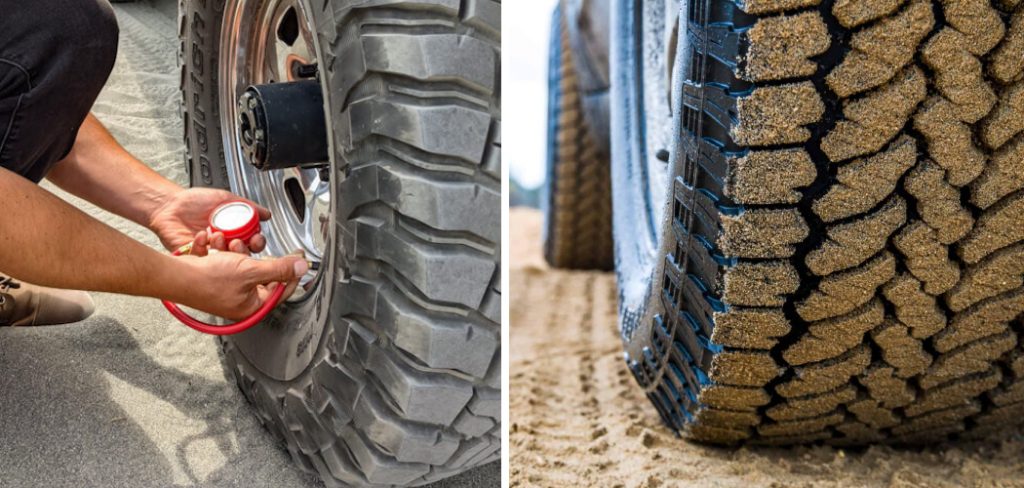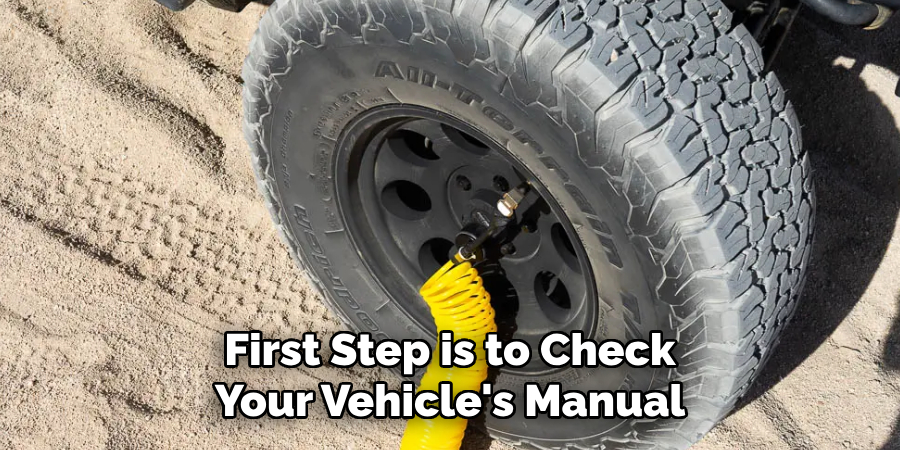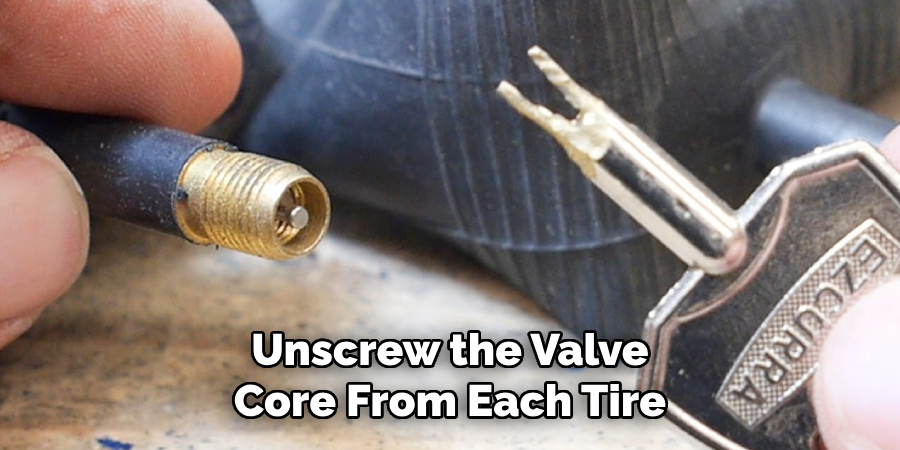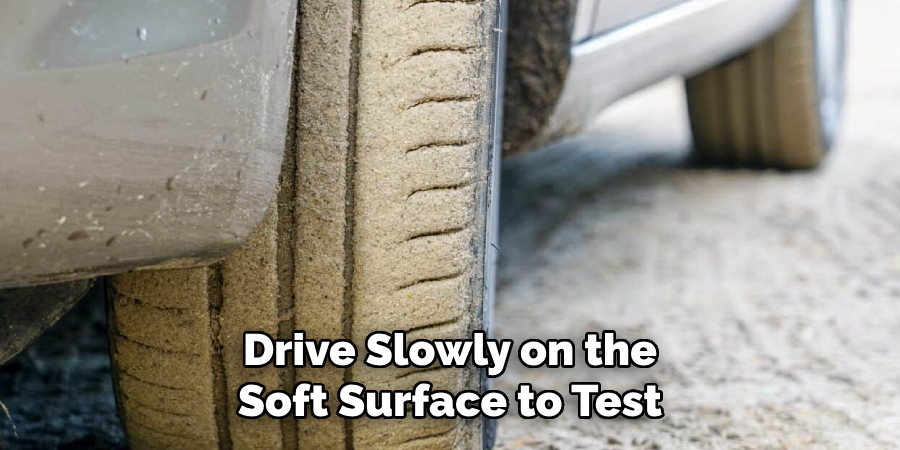Vacationing near sandy beaches or desert roads is always fun, but getting stuck in soft sand can ruin the experience. While 4×4 vehicles and high clearance help navigate loose surfaces, one essential technique many drivers overlook is how to properly air down their tires. The right air pressure makes all the difference when traversing soft terrain.

In this post, I will explain the benefits of reducing tire pressure for sand and provide a step-by-step guide on how to air down tires for sand for airing down safely. Whether you’re headed to the dunes or beaches for the weekend, following these tips will help you enjoy off-road adventures without getting bogged down in the mud or buried in the sand.
Why Air Down Tires for Sand?
Before learning how to air down tires, it’s essential to understand why this technique is necessary. Soft sand or mud can trap a vehicle and make it challenging to drive. Reducing tire pressure increases the surface area of the tire in contact with the ground, which helps distribute its weight more evenly.
Therefore, the tire won’t sink as much into soft surfaces, providing better traction and reducing the risk of getting stuck. Additionally, lower tire pressure also provides a more comfortable ride on rough terrain by absorbing shocks on an uneven surface.
Needed Tools and Materials
Given below are some tools and materials you will need before airing down your tires for sand:
- Tire Pressure Gauge
- Air Compressor
- Valve Stem Tool or a Small Screwdriver
- Gloves (Optional)
- Pressure Chart for Your Tires (Optional)
10 Simple Step-by-step Instructions on How to Air Down Tires for Sand
Step 1: Know Your Vehicle’s Recommended Tire Pressure

The first step is to check your vehicle’s manual or the sticker on the driver-side door jamb for the recommended tire pressure. This information is crucial as it ensures you don’t under or overinflate your tires. You can also refer to the pressure chart for your tires, which is usually found on the manufacturer’s website.
It’s always best to follow the recommended pressure for optimal performance and safety. The recommended tire pressure for most vehicles is between 30-35 PSI.
Step 2: Find a Safe Spot to Park
Choose a flat, level surface that’s away from traffic and has enough space for you to work around the vehicle. You can also use a pair of wheel chocks or rocks to prevent the vehicle from rolling while you’re working.
The ideal location would be close to an air compressor, but if one isn’t available, you can carry a portable air compressor with you for convenience. It’s important to note that this process works best when the tires are cold, so try to do it before driving.
Step 3: Check the Tires’ Current Pressure
Use a tire pressure gauge to check the current pressure of each tire. Make sure all tires are at the same PSI before you start airing down. If there is a significant difference in pressure, you may need to look for any potential leaks or punctures before proceeding. It’s also best to check the pressure before and after driving on soft sand for comparison.
Step 4: Remove Valve Stem Caps
Using a valve stem tool or a small screwdriver, remove the valve stem caps from each tire. Keep them in a safe place to avoid losing them. You only need to remove the cap from the valve stem, not the entire valve. But if you accidentally remove the entire valve, don’t worry; you can easily screw it back on.
Step 5: Use the Valve Core Tool

If you have a valve core tool, use it to unscrew the valve core from each tire. This will release all the air in the tires quickly. If you don’t have one, you can also use a small screwdriver or similar tool to press down on the valve core’s center pin until you hear air coming out. The valve core tool is more efficient and reduces the risk of damaging the valve core. It’s also handy to have in case you need to add air back to your tires after driving on soft sand.
Step 6: Check Tire Pressure Again
After releasing all the air, check the tire pressure again using a tire pressure gauge. The goal is to reduce the pressure by 10-15 PSI from the recommended amount. For example, if your vehicle requires 35 PSI, aim for 20-25 PSI after airing down. Repeat this process for all tires and make sure they are at the same pressure.
Step 7: Air Down Further If Needed
If you’re driving on particularly soft or deep sand, you may need to reduce the tire pressure even more. This will depend on various factors such as your vehicle’s weight, tire size, and the depth of sand. It’s always better to start with a lower pressure, as it can be increased later if necessary. You can also use a pressure chart for your tires to determine the best pressure for the type of sand you’re driving on.
Step 8: Drive Slowly

After reducing tire pressure, drive slowly on the soft surface to test how well your vehicle handles. Keep an eye on the tires’ sidewalls; they should bulge slightly but not too much. If they bulge too much, you may need to reduce the pressure further. Continue driving slowly until you reach your desired destination.
Step 9: Air Up Before Hitting Hard Surfaces
Once you’re finished driving on soft surfaces, it’s essential to air up your tires before hitting hard surfaces like pavement or gravel roads. This will help prevent tire damage and improve handling and fuel efficiency. Use an air compressor to add air back to your tires, and make sure they reach the recommended pressure.
Step 10: Clean Up
After you’re done with your off-road adventure, don’t forget to clean up the area before leaving. Put on your gloves (optional) and put the valve stem caps back on each tire. Also, remember to replace the valve cores if you removed them using a valve core tool. This will ensure your tires are ready for your next off-road adventure.
Following these simple steps on how to air down tires for sand will help you safely and effectively air down your tires for sand. Remember to always check the recommended pressure for your vehicle and adjust it according to your specific needs. This will provide a smoother ride, and better traction, and reduce the risk of getting stuck in soft sand. Happy off-roading!
Frequently Asked Questions
Q1. How Do I Know if I Need to Air Down My Tires for Sand?
A1. If you’re planning to drive on soft sand, it’s recommended to air down your tires for better traction and a smoother ride. You can also look out for signs like spinning wheels, struggling to move forward, or getting stuck in the sand. These are all indications that you need to reduce your tire pressure.
Q2. Can I Air Down My Tires for Sand Without a Pressure Gauge?
A2. It’s not recommended to air down your tires without a pressure gauge as you may end up under or over-inflating them, which can cause issues with handling and safety. A tire pressure gauge is an essential tool for this process, and it’s best to have one handy at all times.
Q3. How Long Should I Drive on Soft Sand Before Airing Down My Tires?
A3. It’s always best to air down your tires before driving on soft sand as it will provide better traction and reduce the risk of getting stuck. However, if you need to drive on soft sand for a short distance, you can still follow the steps mentioned above before heading back onto harder surfaces.

Q4. Can I Use This Method for All Types of Sand?
A4. Yes, this method can be used for all types of sand, including dry and wet sand. However, the recommended tire pressure may vary depending on the type and depth of the sand you’re driving on. It’s best to consult a pressure chart or adjust the pressure according to your specific needs.
Conclusion
In conclusion on how to air down tires for sand, learning how to air down tires for sand can make a huge difference in your off-roading experience. From improving traction and reducing the risk of getting stuck, to protecting your vehicle’s suspension and increasing fuel efficiency, it is a valuable skill for any avid off-roader.
We have covered the essential steps and factors to consider when deflating your tires, such as proper equipment, target pressure levels, and monitoring tools.
Remember to always follow safety precautions and regulations when airing down on public beaches or designated off-road areas. And don’t forget about the importance of airing back up after your adventure! So next time you find yourself tackling sandy terrain, be sure to use these tips and techniques for a smoother and more enjoyable ride. Trust us, your vehicle (and wallet) will thank you. Happy off-roading!

